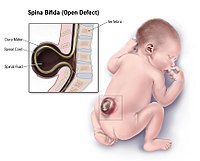Neural Tube Defects, X-Linked

For a general phenotypic description and a discussion of genetic heterogeneity of neural tube defects, see 182940 and 601634.
InheritanceToriello et al. (1980) observed either anencephaly or spina bifida in 5 males in 5 different sibships spanning 4 generations genealogically connected through females.
Baraitser and Burn (1984) and Toriello (1984) reported additional kindreds with pedigree patterns strongly supporting X-linked recessive inheritance. Baraitser and Burn (1984) reported a nonconsanguineous Pakistani Muslim family in which a woman had 3 brothers and 3 sons with neural tube defects, including posterior encephalocele and spina bifida cystica.
Jensson et al. (1988) reported an Icelandic family in which 5 males had either anencephaly or spina bifida: 2 had spina bifida, 2 sibs had anencephaly, and 1 had both high and low spinal lesions. Affected persons came from 4 sibships in 3 generations connected through females.
MappingNewton et al. (1991) presented initial linkage data suggesting linkage of spina bifida with DNA probes on Xp. However, in the large Icelandic family reported by Jensson et al. (1988), the largest family showing apparent X-linked recessive inheritance of neural tube defects, Newton et al. (1994) performed 2-point linkage analysis using markers from 62 informative loci and found no significant evidence for linkage to the X chromosome. Haplotypes were extensively analyzed and found to exclude linkage to the X chromosome. Newton et al. (1994) concluded that involvement of a major X-linked gene is unlikely.
CytogeneticsFryns et al. (1996) reported a de novo/autosomal translocation, t(X;22)(q27;q12.1), associated with lumbosacral spina bifida and myeloschisis. Hol et al. (2000) performed detailed molecular analysis on the U.S. family reported in abstract by Goerss et al. (1993) in which 2 brothers, their mother, and their maternal grandmother had a duplication of Xq26-q27. The brothers carrying the duplication displayed spina bifida and panhypopituitarism (312000), whereas a third healthy brother inherited the normal X chromosome. Preferential inactivation of the X chromosome containing the duplication was evident in healthy carrier females. Hol et al. (2000) hypothesized that the spina bifida in the 2 brothers was due to an interruption of a critical gene in the Xq27 breakpoint region and narrowed the interval to Xq27.3 between DXS369 and DXS1200.